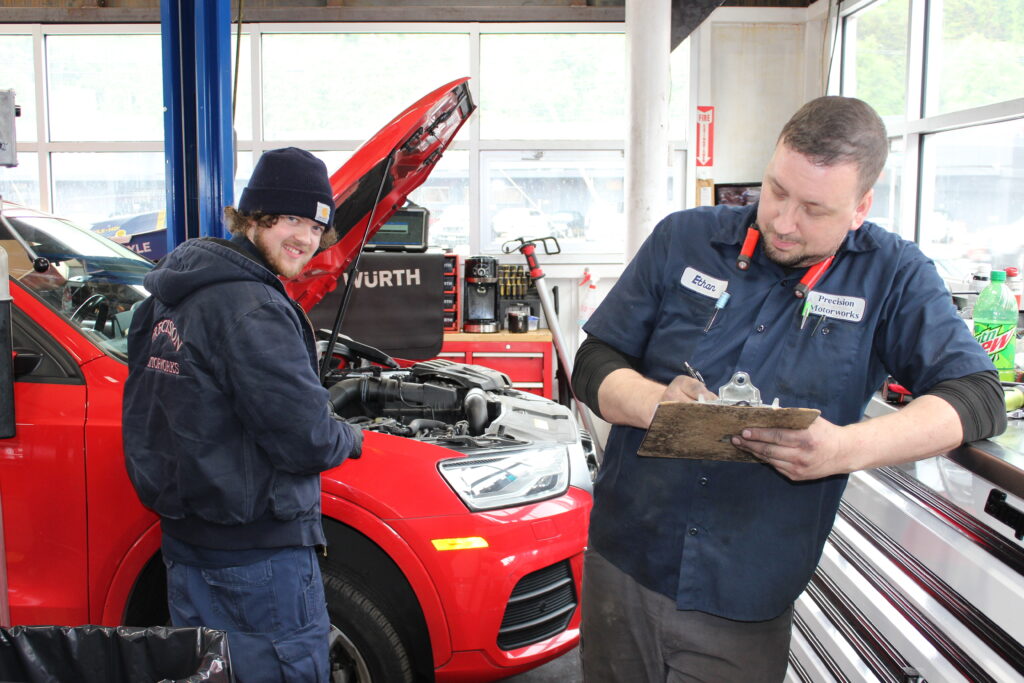Audi PCV Replacement Seattle
Chances are if you are reading this article your Audi’s PCV system is having problems. At Precision Motorworks in Seattle, your local Audi repair shop, we are very familiar with Audi PCV systems and common failures. Let’s dive into the the details! PCV systems usually fail in one of a few ways. External oil leakage, pressure regulating diaphragm failure, or electronic failure. Often your Audi’s PCV system may be functioning properly, but leaking oil externally. External oil leaks need to be repaired since oil buildup can present a fire hazard if near the exhaust, or damage plastic or rubber components it leaks on. There are many rubber seals within the PCV system, and since it contains oil within, the degradation of those seals can cause the oil to leak out. Usually the entire component will need to be replaced along with the seal, as plastic will degrade and warp over time, meaning replacing only the gasket is rarely a long-term solution.
Another common issue with the PCV system is failure of the rubber pressure regulating diaphragm. As expected, a thin piece of rubber will not last forever, especially in the high heat, high stress environment of your engine. When this diaphragm fails, you may hear strange screeching or humming noises from the rubber flapping around, and experience rough running or a check engine light on the dash. You may also notice your engine oil will deplete without leaking externally. This is because the oil separation is not occurring properly, allowing the oil to be burnt off when recirculated, instead of draining back into the oil pan. Additionally, improper crankcase pressure from a failed PCV can cause unrelated seals to leak. Certain seals and gaskets around the engine are designed to seal against only a certain pressure, and when the internal pressure is out of specification, you may be facing expensive oil leak repairs as a result of a bad PCV system. At Precision Motorworks, we will let you know at the first signs of a failing PCV on your Audi in order to help protect your engine’s gaskets and increase longevity.
Recently, manufacturers have been incorporating electronic management and control into the PCV system. This allows the engine’s computer to monitor its operation and efficiency, but unfortunately this also creates another failure point.
What is a PCV system?
PCV stands for Positive Crankcase Ventilation, or occasionally Pressure Control Valve. Both accurately describe the purpose of the system, which is to regulate the internal engine crankcase pressure.
What is crankcase pressure and why is it important?
Crankcase pressure is a side effect of the massive forces taking place in your internal combustion engine. Your engine uses the combustion reaction of fuel to convert its chemical potential energy into kinetic energy. In this process, aside from thermal energy, the main byproduct is combustion gases, also known as exhaust. During this process not all gasses are contained within the combustion chamber, and a small amount will escape into the engine’s crankcase. Engines are usually sealed in order to keep the oil in and the contaminants out. This creates a problem as the excess crankcase pressure will have nowhere to go, causing it to essentially explode out of the weakest seal. This is why a properly functioning crankcase vent system is crucial.
Early Crankcase Vent Systems
In the early days of the combustion engine, the issue of excess crankcase pressure was quickly discovered, and dealt with by simply dumping the excess gasses and vapors on the road through a vent pipe. The problem with this being, of course, dumping a blend of toxic gasses and oil vapor on the road was terrible for the environment. With stricter governmental emissions regulations placed on vehicles through the 1960s and 70s a better method of dealing with this byproduct needed to be developed.
How do Audi PCV Systems Work?
While each manufacturer implements this now federally mandated system in different ways, we specialize in European vehicles, and thus I’ll focus mainly on variants used by our commonly serviced makes. Keep in mind many Japanese and domestic vehicles implement this system differently, so this information may not be relevant to all makes and models. Generally speaking, PCV systems on most European vehicles incorporate two main functions: the pressure control system, aimed at regulating proper internal crankcase pressure, and an oil separator, aimed at separating out oil vapors from the crankcase gasses. The PCV system will separate oil vapors from other crankcase gasses, then recirculate the gas back into the intake to be re-burned, greatly reducing the environmental impact of such emissions.
An air/oil separator is a critical component of your engine’s crankcase vent system. To understand why, you’ll need to first understand why oil vapors are created within an engine. In order to retain as much of the combustion energy as possible, a tight seal must be made in the combustion chamber, yet also allow for up and down movement of the piston. This job is up to the piston rings, which seal the piston to the chamber walls. Since both piston rings and combustion chambers are made from hard, noncompliant materials, without some form of lubrication they would quickly wear each other down. This is one of the most critical jobs of engine oil, to prevent wear between the piston rings and combustion chamber wall. As such, a thin film of oil must endure the scorching temperatures of combustion. It is perfectly normal for the oil to be vaporized on exposure to such heat. There are several methods commonly used to separate oil from crankcase vapors, the most common of which are cyclone style oil separators, and centrifugal style oil separators.
Centrifugal oil separators operate a spinning centrifuge, usually driven by the rotation of one of the engine’s camshafts, to push heavier oil outwards and back down to the oil pan, while collecting the cleaned gasses for reburn. This system is commonly used on Mercedes-Benz vehicles.
Cyclone oil separators operate on a similar principal, spinning the mixture around forcing the heavier oil outwards and separating it from the air. However, this style does not use mechanical spinning, but instead air vortices created by conical vortex generators. While this may seem complex, this technology is relatively robust since it utilizes less moving parts.
The other part of the PCV system functions to regulate the pressure within the crankcase. Most modern combustion engines rely on a very consistent level of pressure within the engine to operate different components, such as valves or pumps. When this pressure is not consistent, these components will not function properly. Furthermore the engine management system needs to keep careful track of how much air is entering the engine in order to calculate and maintain the proper air fuel mixture to facilitate efficient combustion. Any imbalance will lead to decreased performance, or even inoperability. The pressure is typically regulated by a calibrated spring, and a flexible diaphragm which opens after the desired pressure is exceeded. The process of air intake into the engine creates a pressure differential in the PCV system which “sucks” the gaseous mixture into the intake to be burned up along with fresh air.
The PCV system is important to regularly inspect for proper operation, as it is vital for the health of your engine. At Precision Motorworks, our Audi specialists will keep an eye out for failing PCV and let you know when it’s time to replace it.

Seattle Audi Repair & Service:
Call or Text:
206-282-1000
Email us at:
service@precisionmotorworks.net

